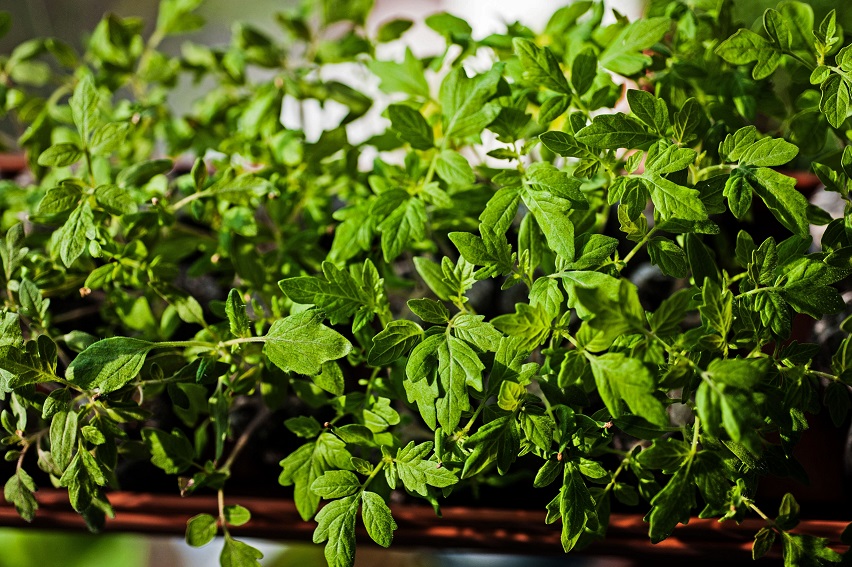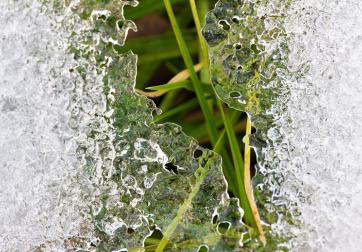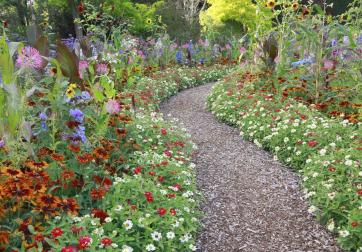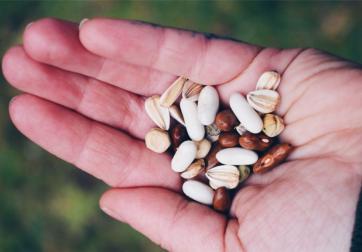
The main reason to grow your own tomatoes is that they taste so good. You can also get the varieties you want; you know they have been grown in healthy organic soil, and they haven’t been sprayed with pesticides.
Now is the time to start your plants from seeds. Wherever you live, count back about eight weeks from your last predicted frost date to your seed planting date. The ideal tomato plant should be six to eight inches tall and dark green, with a stocky stem and well-developed root system at the time of planting. Normally, six to eight weeks are required to produce this type of plant from seed.
Start with a good soilless seed starting mix made with vermiculite and perlite and add enough warm water to make it moist. I just pour warm water straight into the bag and mush everything around until it is evenly moist like a wrung-out sponge but not so wet that water runs out when you squeeze a handful. You can buy containers specifically for seed starting or recycle containers like the ones that strawberries come in. These are handy because they already have drainage slits in the bottom, and the clear lid makes a perfect little mini greenhouse. Plant the seeds only about ¼ inch deep and firm the top gently so seeds have good contact with the damp mix.
Put containers where it is warm, and your seeds should germinate in only a few days. Setting containers on a heat mat or even a heating pad wrapped in a towel promotes quicker germination. Remove plants from the heat mat once they are up and growing. Keep soil moist, but not too wet, by setting the container inside a larger container with warm water and watering from the bottom when you water. Place plants two inches below a fluorescent light for about 15 hours a day and transplant them to larger containers as the plants grow. You don’t have to buy expensive plant grow lights – a shop light will work just fine. Research has shown that brushing the plants gently with your fingers each day produces stronger plants. You can also use a fan to circulate air around the plants to promote strong stems.
Each time you transplant, remove the lower leaves and plant deeply because tomato plants grow roots all along the covered stem. When you transplant into larger containers, it is time to switch to a good soilless potting/container mix instead of a seed starting mix because it will help support the plants better as they get bigger. You can fertilize with a liquid organic fertilizer such as seaweed, fish emulsion, or compost tea at half-strength once the plants are growing well about every other time you water. If you fertilize too much, your plants will grow too tall too fast and become floppy and leggy instead of strong and stocky.
Harden off your plants for about a week before planting into the garden by setting them outside a few hours each morning in an area protected from sun and wind. Increase the time and exposure daily. It is usually safe to plant outside after April 15th where I live in Oklahoma. Again, check to determine your last predicted frost. You know what I mean when I say “predicted.” That is not a precise date and can vary greatly from year to year. If you just can’t wait, go ahead and plant a few tomato plants earlier and provide protection from cold by using “Wall O’ Water” enclosures, gallon milk cartons, clear soda bottles filled with water surrounding the plants, or clear plastic around your tomato cages which turns them into greenhouses. Remove the plastic or enclosures once the weather has warmed and settled and plants are growing well. If your plants get tall and leggy because you tried to grow them in a south-facing window and the sun didn’t shine every day, just lay them on their side in a trench and cover everything except the top leaves. Wrap a strip of newspaper around the stem when you plant to protect from cutworms. Tomatoes like it hot, so wait until the soil temperature warms up to put a 4” mulch of compost, leaves, straw, pine needles, bark mulch, or other organic matter around your plants. The mulch will keep down weeds and conserve moisture. If you mulch before the soil gets warm, it will delay growth of plants and ripening of the first tomatoes.
Tomato plants need plenty of water regularly to grow well. Remember, water deeply and less often so the roots will grow deep and be protected from heat and drought. Tomatoes won’t set fruit if the temperatures get above 90 degrees during the daytime and 80 degrees at night for several nights in a row. If it is extremely windy for an extended time during blossoming, the blooms can actually dry up and blow off. Smaller fruited tomatoes can take more heat than larger ones and keep producing. Makes you wonder how we ever manage to grow tomatoes at all! Check with your state agriculture college for factsheets on growing tomatoes. They will give you all the information you need to grow the best tomatoes ever along with recommend best varieties for your area.
After you pick your vine-ripened tomatoes, do not store them in the refrigerator. The cold temperature destroys the flavor and texture and ruins all your hard work. I had ripe tomatoes until Christmas this year because I picked all the green tomatoes before the first frost, and they ripened gradually in the garage. They weren’t quite as good as vine-ripened tomatoes; however, they were really good and better than store-bought.
National Garden Clubs, Inc. is a 501(c)(3) organization that aims to promote the love of gardening, floral design, and civic and environmental responsibility. There is a local club near you, click here to find one and join. Subscribe to the NGC’s blog by entering your e-mail here. You do not have to be an NGC member to subscribe. NGC welcomes blog article submissions, e-mail the Blog Administrator at blog@gardenclub.org.

 Board Member Login
Board Member Login Our Store
Our Store Blog
Blog





